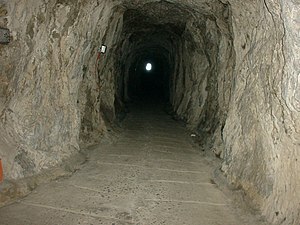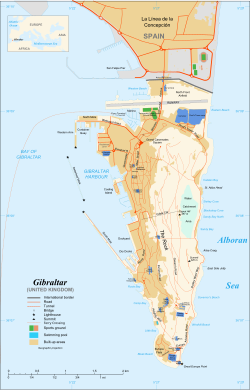Great Siege Tunnels
| Great Siege Tunnels | |
|---|---|
| Upper Galleries | |
| Part of Fortifications of Gibraltar | |
| Northern end of the Rock of Gibraltar | |

Great Siege Tunnels in the Rock of Gibraltar.
|
|
| Coordinates | 36°08′43″N 5°20′42″W / 36.145153°N 5.345047°W |
| Type | Tunnel |
| Site information | |
| Owner | Government of Gibraltar |
| Controlled by | Gibraltar Tourist Board |
| Open to the public |
Partially open |
| Site history | |
| Built | 1779? |
| Built by | Soldier Artificer Company |
| Materials | Limestone |
| Battles/wars | Great Siege of Gibraltar |
The Great Siege Tunnels in the British Overseas Territory of Gibraltar, also known as the Upper Galleries, are a series of tunnels inside the northern end of the Rock of Gibraltar. They were dug out from the solid limestone by the British during the Great Siege of Gibraltar at the end of the 18th century.
The Great Siege was an attempt by France and Spain to capture Gibraltar from Great Britain during the American Revolutionary War. It was the fourteenth and final siege of Gibraltar, which lasted from July 1779 to February 1783. During the siege, British and Spanish forces faced each other across an approximately 1 kilometre (0.62 mi) wide stretch of the marshy open ground that forms the disputed isthmus immediately to the north of the Rock of Gibraltar. The British lines blocked access to the City and the western side of the island, while eastern side of the island was inaccessible because of its steep terrain. Guns were placed in a series of batteries on the north face of The Rock, providing overlapping fields of fire so that infantry attacks would come under heavy fire throughout their advance.
The impetus for the construction of the tunnels came from the garrison's need to cover a blind angle on the north-east side of The Rock. The only solution found to cover that angle was via a gun mounted on a spur of rock known as The Notch. There was no possibility of building a path there due to the vertical cliff face, so Sergeant-Major Henry Ince of the Military Artificers suggested digging a tunnel to reach it. His plan was approved and construction work began on 25 May 1782.
...
Wikipedia

